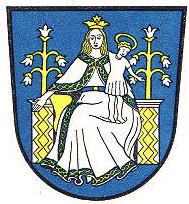Lilienthal: Difference between revisions
Jump to navigation
Jump to search
Knorrepoes (talk | contribs) No edit summary |
Knorrepoes (talk | contribs) m (Text replace - "{|width="100%" style="color:black; background-color:#ffffcc;" |width="15%"|50 px|left |width="70%" align="center" |'''Heraldry of the World<br/>Civic heraldry of Germany - [[Deutsche Wappen|Deutsche Wappen (Gemeind) |
||
| Line 1: | Line 1: | ||
{ | {{de}} | ||
'''LILIENTHAL''' | '''LILIENTHAL''' | ||
Revision as of 10:51, 25 January 2015
This page is part of the German heraldry portal |
Heraldry of the World |
|
German heraldry:
|
Selected collector's items from Germany:
|
LILIENTHAL
State : Niedersachsen
District (Kreis) : Osterholz
Additions : 1974 Heidberg, Sankt Jürgen, Seebergen und Worphausen
Official blazon
Origin/meaning
The arms were granted in 1956 and were based on the old arms of the Amt Lilienthal. These in turn were based on the arms of the Cistercian monastery founded in 1232 by Gerard von der Lippe, Archbishop of Bremen. The St. Mary is the patron saint of the monastery, the lilies are canting as well as a symbol for the St. Mary.
Contact and Support
Partners:
Your logo here ?
Contact us
© since 1995, Heraldry of the World, Ralf Hartemink 
Index of the site
Literature : Stadler, K. : Deutsche Wappen - Bundesrepublik Deutschland. Angelsachsen Verlag, 1964-1971, 8 volumes.












